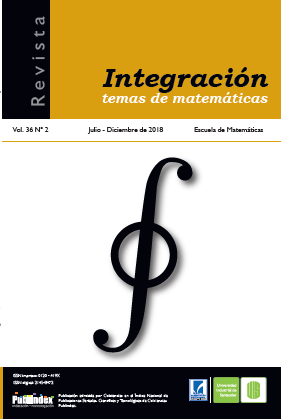Numerical solution of an inverse problem by applying a continuous genetic algorithm
Published 2018-12-11
Keywords
- Continuous genetic algorithm,
- calibration,
- parameter identification,
- sedimentation
How to Cite
Abstract
In this paper we consider the problem of flux determination in a scalar conservation law modeling the phenomenon of sedimentation. The experimental observation data used for the calibration consist of a solid concentration profile at a fixed time. The identification problem is formulated as an optimization one, where the distance between the profiles of the model simulation and observation data is minimized by a least squares cost function. The direct problem is approximated by a monotone finite volume scheme. The numerical solution of the calibration problem is obtained by a continuous genetic algorithm. Numerical results are presented in order to validate the efficiency of the proposed algorithm.
Downloads
References
[2] Bürger R., Coronel A. and Sepúlveda M., “A numerical descent method for an inverse problem of a scalar conservation law modelling sedimentation”, in Numerical Mathematics and Advanced Applications: Numerical Mathematics and Advanced Applications: Proceedings ENUMATH 2007, Springer Verlag, Providence, RI (2008), 225–232.
[3] Bürger R., Coronel A. and Sepúlveda M., “Numerical solution of an inverse problem for a scalar conservation law modelling sedimentation”, in Hyperbolic problems: theory, numerics and applications, volume 67 of Proc. Sympos. Appl. Math., Amer. Math. Soc., Providence, RI (2009), 445–454.
[4] Bürger R. andWendlandW. L., “Sedimentation and suspension flows: historical perspective and some recent developments”, J. Engrg. Math. 41 (2001), No. 2-3, 101–116.
[5] Bustos M. C., Concha F., Bürger R. and Tory E. M., Sedimentation and thickening, vol 8 of Mathematical Modelling: Theory and Applications, Kluwer Academic Publishers, Dordrecht, 1999.
[6] Concha F. and Bürger R., “Thickening in the 20th century: a historical perspective”, Minerals & Metallurgical Process 20 (2003), No. 2, 57–67.
[7] Engquist B. and Osher S., “One-sided difference approximations for nonlinear conservation laws”, Math. Comput. 36 (1981), 321–351.
[8] Eymard R., Gallouët T. and Herbin R., “Finite volume methods”, in Handbook of numerical analysis, Volume VII: Handb. Numer. Anal. North-Holland, Amsterdam, (2000), 713–1020.
[9] Fogel L.J., Owens A.J. and Walsh M.J., Artificial intelligence through simulated evolution, Wiley, Chichester, WS, UK, 1966.
[10] Gaffney J., Pearce C. and Green D., “Binary versus real coding for genetic algorithms: A false dichotomy?”, ANZIAM J. 51 (EMAC2009), C347–C359, 2010.
[11] Goldberg D.E., Genetic Algorithms in Search, Optimization and Machine Learning, Addison-Wesley Longman Publishing Co., Inc., Boston, MA, USA, 1st edition, 1989.
[12] Hansen N., Auger A., Ros R., Finck S. and Pošík P., “Comparing results of 31 algorithms from the black-box optimization benchmarking bbob-2009”, in Proceedings of the 12th Annual Conference Companion on Genetic and Evolutionary Computation, GECCO ’10, New York, NY, USA, (2010), 1689–1696.
[13] Haupt R.L. and Haupt S.E., Practical genetic algorithms, Wiley-Interscience [John Wiley & Sons], Hoboken, NJ, second edition, 2004.
[14] Holland J.H., Adaptation in Natural and Artificial Systems, University of Michigan Press, Ann Arbor, MI, USA, 1975.
[15] Koza J.R., Genetic Programming: On the Programming of Computers by Means of Natural Selection, MIT Press, Cambridge, MA, USA, 1992.
[16] Kynch G.J., “A theory of sedimentation”, Trans. Faraday Soc 48 (1952), 166–176.
[17] LeVeque R.J., Numerical methods for conservation laws, Lectures in Mathematics ETH Zürich, Second edition, Basel: Birkhäuser Verlag, 1992.
[18] Michalewicz Z., Genetic algorithms + data structures = evolution programs, Artificial Intelligence, Springer-Verlag, Berlin, 1996.
[19] Rechenberg I., Evolutionstrategie: Optimierung Technisher Systeme nach Prinzipien des Biologischen Evolution, Fromman-Hozlboog Verlag, Stuttgart, 1973.
[20] Sweeney M.W. and Kabouris J.C., “Modeling, Instrumentation, Automation, and Optimization of Water Resource Recovery Facilities”, Water Environment Research 88 (2016), 1279–1298.
[21] Sivanandam S. N. and Deepa S. N., Introduction to genetic algorithms, Springer, Berlin, 2008.
[22] Tan Ch. K., Bao J. and Bickert G., “A study on model predictive control in paste thickeners with rake torque constraint´”, Mineral Engineering 105 (2017), 52–62.
[23] Toro E.F., Riemann solvers and and numerical methods for fluid dynamics: A practical introduction, Third edition, Springer-Verlag, Berlin, 2009.
[24] Xu N., Wang X., Zhou J., Wang Q., Feng W. and Peng X., “An intelligent control strategy for thickening process”, International Journal of Mineral Processing 142 (2015), 56–62.
